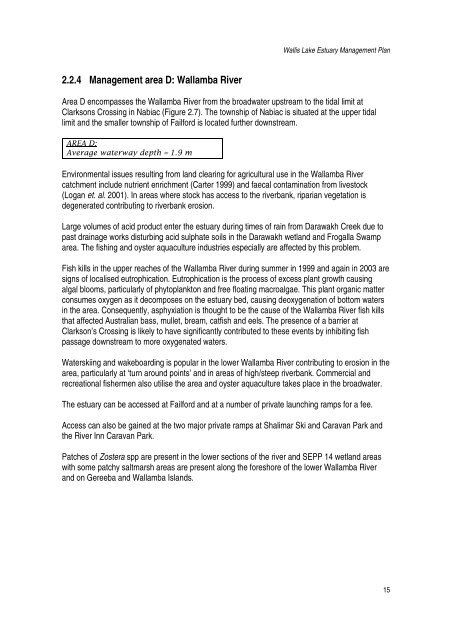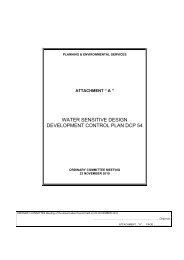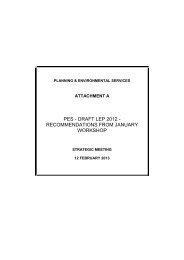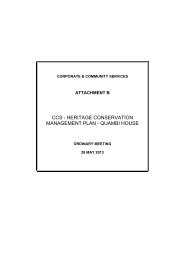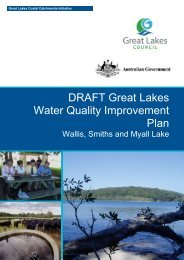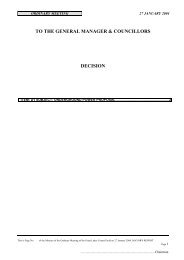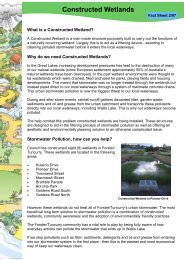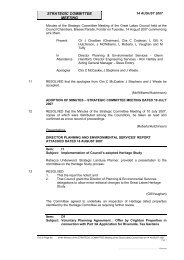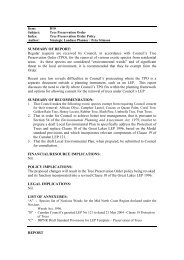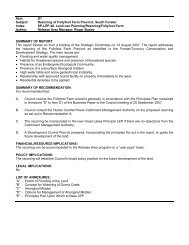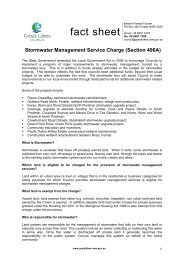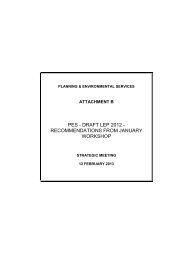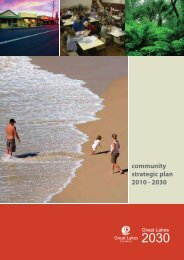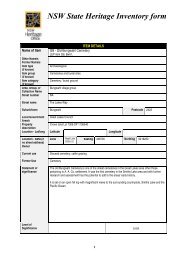13.2 The Wallis Lake Estuary Management Committee - Great Lakes ...
13.2 The Wallis Lake Estuary Management Committee - Great Lakes ...
13.2 The Wallis Lake Estuary Management Committee - Great Lakes ...
You also want an ePaper? Increase the reach of your titles
YUMPU automatically turns print PDFs into web optimized ePapers that Google loves.
<strong>Wallis</strong> <strong>Lake</strong> <strong>Estuary</strong> <strong>Management</strong> Plan<br />
2.2.4 <strong>Management</strong> area D: Wallamba River<br />
Area D encompasses the Wallamba River from the broadwater upstream to the tidal limit at<br />
Clarksons Crossing in Nabiac (Figure 2.7). <strong>The</strong> township of Nabiac is situated at the upper tidal<br />
limit and the smaller township of Failford is located further downstream.<br />
AREA D:<br />
Average waterway depth ≈ 1.9 m<br />
Environmental issues resulting from land clearing for agricultural use in the Wallamba River<br />
catchment include nutrient enrichment (Carter 1999) and faecal contamination from livestock<br />
(Logan et. al. 2001). In areas where stock has access to the riverbank, riparian vegetation is<br />
degenerated contributing to riverbank erosion.<br />
Large volumes of acid product enter the estuary during times of rain from Darawakh Creek due to<br />
past drainage works disturbing acid sulphate soils in the Darawakh wetland and Frogalla Swamp<br />
area. <strong>The</strong> fishing and oyster aquaculture industries especially are affected by this problem.<br />
Fish kills in the upper reaches of the Wallamba River during summer in 1999 and again in 2003 are<br />
signs of localised eutrophication. Eutrophication is the process of excess plant growth causing<br />
algal blooms, particularly of phytoplankton and free floating macroalgae. This plant organic matter<br />
consumes oxygen as it decomposes on the estuary bed, causing deoxygenation of bottom waters<br />
in the area. Consequently, asphyxiation is thought to be the cause of the Wallamba River fish kills<br />
that affected Australian bass, mullet, bream, catfish and eels. <strong>The</strong> presence of a barrier at<br />
Clarkson’s Crossing is likely to have significantly contributed to these events by inhibiting fish<br />
passage downstream to more oxygenated waters.<br />
Waterskiing and wakeboarding is popular in the lower Wallamba River contributing to erosion in the<br />
area, particularly at ‘turn around points’ and in areas of high/steep riverbank. Commercial and<br />
recreational fishermen also utilise the area and oyster aquaculture takes place in the broadwater.<br />
<strong>The</strong> estuary can be accessed at Failford and at a number of private launching ramps for a fee.<br />
Access can also be gained at the two major private ramps at Shalimar Ski and Caravan Park and<br />
the River Inn Caravan Park.<br />
Patches of Zostera spp are present in the lower sections of the river and SEPP 14 wetland areas<br />
with some patchy saltmarsh areas are present along the foreshore of the lower Wallamba River<br />
and on Gereeba and Wallamba Islands.<br />
15


